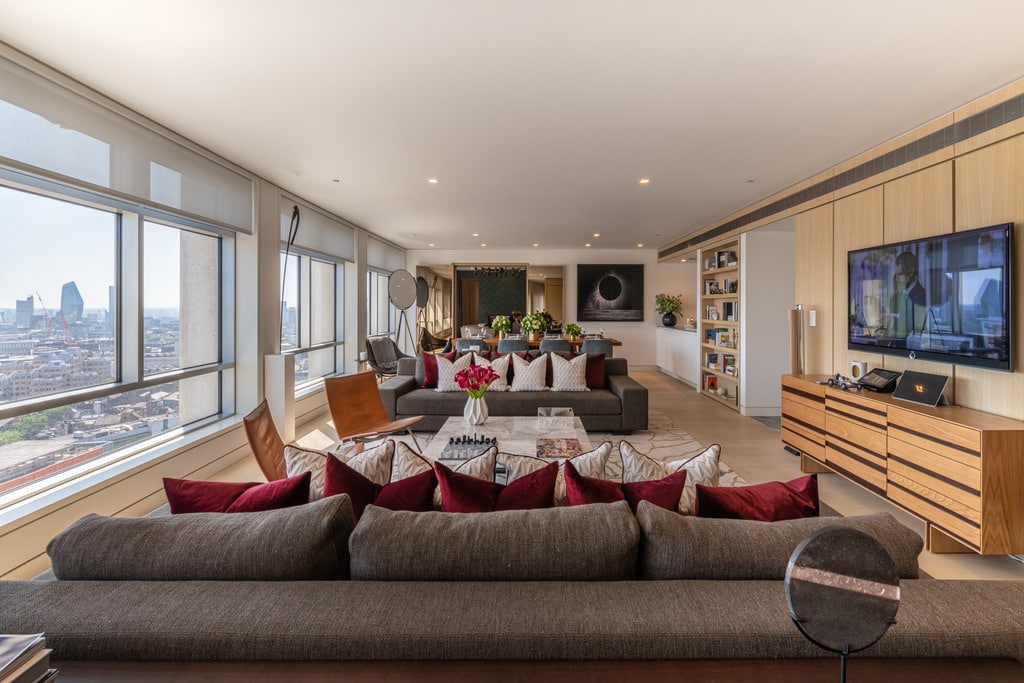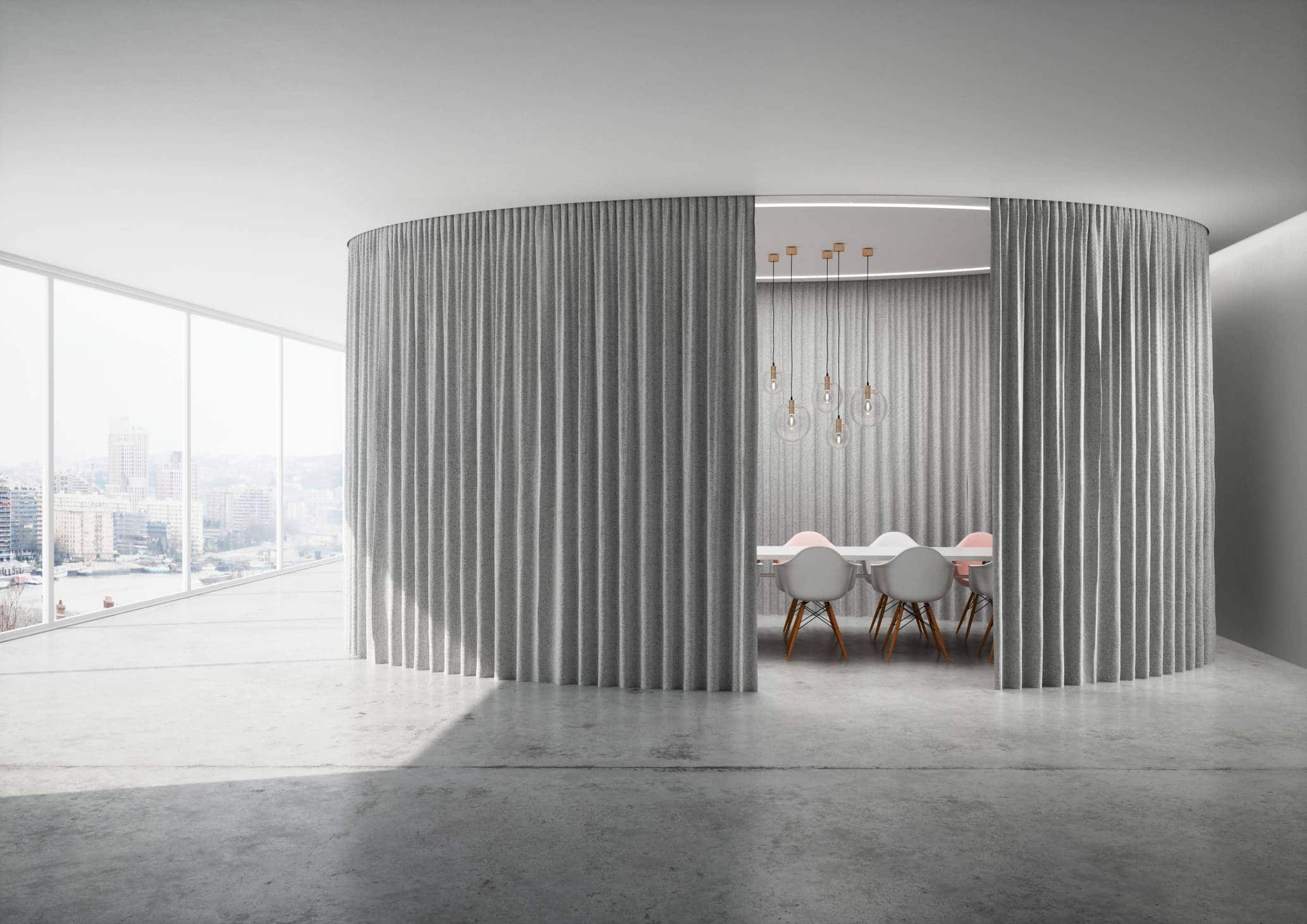
The 5 trends shaping the industry in 2022
“Workplace envy” is one of the most unexpected outcomes of the pandemic, as firms invest in their office environments to entice employees back following long periods of working from home. As a result, interior design and refurbishment projects are increasingly turning to textiles for flexibility, sustainability and a softer feel to what some consider to be the harsh reality of the office.
Here are some of the key trends we expect to see from specifiers in 2022.
Flexible Workspaces
Offices are becoming more flexible. With teams rotating, smaller spaces are the norm. However, the occasional meeting or conference means those walls must be pushed back to give each participant as much room as possible given continued Covid responsibilities. Curtained-off booths are proving the answer for many, as shown at the Panagram building in Camberwell and Bureau’s coworking space in Greenwich Design District.
Left to right: Room divider curtains at Panagram, designed by Buckley Grey Yeoman, acoustic curtains for meeting booths at Bureau’s coworking space in Building C3, Greenwich Design District
More sustainable materials and processes
Half of all curtain and blinds specifications now come with sustainability criteria. The London Plan is setting a standard likely to be followed by other cities. Developers and architects must ensure every aspect of the building exceeds expectations. So they require materials made from recycled content and simple-to-repair forms which can themselves be recycled.
Above: The Mayor’s London Plan is a spatial development strategy setting out an economic, environmental, transport and social framework for the development of London to 2036.
‘No VOC’ stipulations are commonplace, which means PVC-free fabrics such as Verosol Enviroscreen are increasingly being specified. As the top developers tackle scope 3 emissions, they are probing further back into the supply chain. Waverley’s access to locally sourced materials and multiple European manufacturing plants has helped secure contracts as specifiers put environmental considerations up the agenda.
Automation
The UK has been a little slow to the party when it comes to automating blinds and curtains. This is changing as the benefits of reducing solar glare while retaining connection to outside and natural light are recognised. Employee wellbeing and performance is improved by ensuring the right level of natural daylight reaches into office buildings.
Automated roller blinds are present at the windows of Centre Point. Waverley supplied and installed 1,500 automated roller blinds, each wired into every room’s Crestron Control System.
It is standard to have floor to ceiling glazing in buildings across London and, while natural daylight is one of the most important elements of any office, solar glare can dazzle occupants and make it impossible to read screens. When buildings, like 22 Bishopsgate, have 3m high ceilings, such levels of natural daylight bring challenges of managing solar heat gain and glare. Solar heat gain has a significant impact on building efficiency, whilst glare has a detrimental impact on employee comfort and productivity. High performance screen fabrics provide good through-vision while their metallised backing reduces glare and solar heat gain. The use of such fabrics combined with automation ensure that working conditions remain at optimum levels in terms of natural daylight and temperature.
Designed by PLP Architecture, 22 Bishopsgate has 3m high ceilings, allowing natural light to flow throughout the building
Home from home
As many employees have benefited from working from home, amid comfortable, warm surroundings, their employers have had to transform the office space in order to tempt them back. Waverley sees much greater uptake of curtains in office buildings as a result. At Alpha Bank and Regent’s Place, curtains add a softer feel and improve acoustics which makes the office space more human and homely.
Above: Waverley’s installation of sheer curtains at a 10m drop at Regents Place marked our highest curtain installation to date.
Curtained off areas at 88 Wood Street facilitate conversation, which is one of the main reasons workers want to see their colleagues face to face. One other aspect has taken off during Covid – the antimicrobial properties of some fabrics further reassure employees that it is safe to return.
Better Acoustics
Many designers are breaking up the open-plan office. They can curtain off a soundproofed area within the open-plan environment and it becomes almost as effective a soundproof barrier as a glazed partition – and twice as attractive. Systems such as Création Baumann Vario feature layers of rubber membrane between acoustic fabrics. They reduce noise by up to 16dB – to absorb sound, rather than just dampening acoustic vibrations.
Above: The Vario Acoustic Curtain System designed by Creation Baumann reduces noise by 23dB
Drop ceilings are also in vogue to improve acoustics in open plan spaces. Products such as Kvadrat soft cell acoustic ceilings and wall panels dampen noise which can otherwise be detrimental to productivity. The panels are clad in many different fabrics so integrate into the interior design.
Above: Kvadrat Acoustics wall panels dampen noise which can otherwise be detrimental to productivity
Expect to see more examples of all these trends in Britain’s commercial property refurbishment and new developments during 2022.
Additional reading
- The London Plan – Spatial Development Strategy
- Considerations when specifying room divider curtains
- Vario by Creation Baumann – a flexible acoustic divider system that reduces noise by 23dB
- Automated Blinds – the importance of considering control and power in the design process






